TEXOMA AREA
JULY/AUGUST 2022

TOM CRUISE BACK ON TOP BREAST CANCER RISKS, SYMPTOMS, AND NEW EARLY DETECTION
HISTORY, SCIENCE MEDICINAL EFFECTS OF LAUGHTER
CHARLES TOULSON, MD, MBA
A PIONEER IN THE FIELD OF ORTHOPEDIC
SURGERY

STAND OUT WITH THE EMINENT CHOICE IN HEALTHCARE

Pain
Orthopedic Surgery • Neurosurgery • Minimally Invasive Spine Surgery
Total Joint Surgery • Foot & Ankle Surgery • Hand Surgery
Gynecological Surgery • Plastic Surgery



ROBOTIC TECHNOLOGY
Orthopedic
TEXOMA AREA • 1 Eminent Medical Center is the premier treatment destination in the Dallas/Fort Worth area
three operating suites and five private patient rooms. www.eminentmedicalcenter.com • (469) 910-8800 1351 W. President George Bush Highway, Richardson, Texas 75080 IN-NETWORK
premier,
area.
are an
with
Eminent Medical Center is a
boutique treatment destination in the DFW
We
In-Network provider with Aetna, Blue Cross Blue Shield, Cigna, and United Healthcare.
surgeons and the medical staff at Eminent Medical Center are excited to offer Zimmer Biomet’s ROSA Knee System, which helps surgeons personalize surgical procedures for their patients. PROVIDING SPECIALTY CARE We provide surgical services for pain management, orthopedic & sports medicine, gynecology, spine surgery and general surgery.
Management • Sports Medicine • General Surgery • Spine Surgery
TOP DOCS 2022 Livingwell PROVIDERS HEALTHCARE AND OTHER

THE HEALING POWER OF
RegenerativeTherapies

Naturally Treat & Heal the Cause of Painful Conditions
Not all Regenerative Medicine Injections are the Same. Regenerative therapies are a spectrum of cutting edge therapeutic techniques used to naturally treat and heal the cause of a painful condition rather than masking the symptom. Regenerative therapies stimulate and accelerate your own body’s natural ability to heal itself. Two of the most effective Regenerative therapies include stem cell and platelet rich plasma injections.
Stem Cells are “undifferentiated” cells, which allow them to develop into another type of cell that is required to repair or replace damaged tissue.
Stem cell therapy can repair tissues that are too damaged to heal on their own. Stem cells can stimulate the formation of cartilage, tendon, ligaments, bone and fibrous connective tissues.

PLATELET RICH PLASMA
Platelet rich plasma (PRP) therapy utilizes platelets taken from the patient’s own blood to rebuild damaged tendons or cartilage.
As a result, the damaged tissue begins to heal. PRP has been successful in not only relieving pain, but also in jump-starting the healing process.
ROBERT J. NOCERINI, MD
Board Certified in Pain Management Board Certified in Anesthesiology
TREATMENTS
Injuries and conditions commonly treated by regenerative therapy procedures include:
• Back & Neck Pain
• Golfer’s Elbow
• Osteoarthritis of the Knee, Hip, & Shoulder
• Tennis Elbow
• Joint Injuries
• Ligament, Cartilage, & Tendon Injuries
THE INJECTION PROCEDURE
SREENADHA VATTAM, MD

Board Certified in Pain Management Physical Medicine and Rehabilitation

MIKE CONNER, APRN, FNP-C Nurse Practitioner

HELENE DEHAAN, FNP Nurse Practitioner
Platelet rich plasma therapy and stem cell injections are done at our office and take about an hour. Patients return home the same day and are often able to work the following day.
EXPERIENCE
Our providers have years of experience in minimally invasive procedures with additional training in regenerative injection techniques. The entire staff is dedicated to providing you with the best possible experience.
Schedule an appointment with one of our providers to determine if one of these state of the art procedures could be right for you.
SHERMAN OFFICE: 1001 Sara Swamy Dr., #220 Sherman, TX 75090 (903) 892-1999
ROWLETT OFFICE: 7700 Lakeview Pkwy. Rowlett, TX 75088 (469) 653-0222

ShermanPain.com
FROM THE PUBLISHER
TOP GUN
Local Dr. Charles Toulson is helping people suffering from a full range of musculoskeletal disorders, diseases, and injuries. Dr. Toulson and his team at Alpha Orthopedics & Sports Medicine share a passion for excellence in orthopedic care and work together to provide just that. Areas of specialty include adult hip and knee reconstruction, adult hip and knee revisions, robotic-assisted joint resurfacing, knee arthroscopy, foot, ankle and trauma. Read about this top doctor and his revolutionary approach to medicine in this issue on page 8.
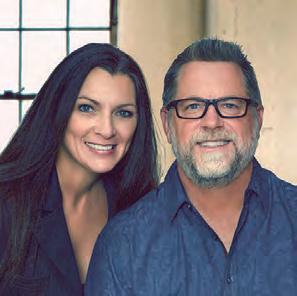
Living Well
JULY/AUGUST 2022
PRESIDENT & CEO SAM HOUSTON
VICE PRESIDENT & CFO
SPRING HOUSTON
EDITOR, FEATURE WRITER & SOCIAL MEDIA
SONDRA BARR
ART DIRECTOR
VANESSA FRYER
ACCOUNTS MANAGER JENNIFER BEAVERS
WEBSITE LYDIA ROGERS
ADVERTISING & SALES
Speaking of being on top, Tom Cruise is back in that position with the release of his latest film. Top Gun: Maverick raked in a record-breaking $157 million its opening weekend and continues to lure people into theaters with high-intensity aerial footage, nostalgia, and the reemergence of Pete ‘Maverick’ Mitchell (aka Tom Cruise, in full beefcake glory). Enjoy the flyby on his career highs and lows on page 24.
Next up is a laughing matter. Seriously! Turns out, laughter may really be the best medicine. We explore the scientific research that backs up the positive effects a good laugh can have on your physical, mental, and emotional health. Laughing is so beneficial to health that laughter therapy has even become an alternative approach to treating depression, stress, and other mood disorders. Learn more laughter and its effects on page 40.
Of course, cancer is no laughing matter. Yet, there is some updated news on breast cancer risks, symptoms, and new revelations on early detection. If you’re at risk of breast cancer, don’t miss the article on page 20.
Be well!

TEXAS: Denton County, Dallas County, Collin County
TEXAS & OKLAHOMA: Texoma Area
WRITE TO US:
Tell us who you would like to see featured on the cover, or what subjects you would like covered in upcoming editions of LIVING WELL MAGAZINE at info@livingwellmag.com
SUBSCRIPTIONS & CUSTOMER INQUIRIES
Houstons of Dallas Publishing, Inc. 102 E. Broadway, #901 Prosper, TX 75078
www.LivingWellmag.com Phone: (214) 507-1000 Fax: (855) 248-2132
LIVING WELL MAGAZINE is a source for quality educational articles on living a healthy, vibrant life. Our focus is on connecting our readers with the latest information on a host of topics relevant to their evolving life. From cutting edge medical news and procedures to top-tier financial, legal and lifestyle information. Connecting readers to leading medical and business professionals in their community in Texas and Oklahoma.
of the goods or services advertised herein. We hereby expressly disclaim any liability with respect to information or goods and services contained herein. We further disclaim any and all warranties or representations, express or implied, with respect to such information, goods or services, including any warranty of merchantability or fitness for a particular purpose (it
4 • JULY/AUGUST 2022
A Health & Lifestyle Magazine for THRIVING ADULTS All advertisements in this Magazine are placed by third parties. We do not control or endorse either the advertisements or their content. Further, we do not manufacture, sell, distribute
provide any
being understood that we do not acknowledge that any such warranty exists). We are not liable or responsible for any loss, injury, damage, or harm that you may suffer as a result of the information contained in any advertisement or goods or services contained herein. “We” refers to the name of this Magazine,
all versions of Living Well Magazine as well as Houstons of Dallas Publishing, Inc.
or
and
SPRING AND SAM HOUSTON
SAM AND SPRING HOUSTON

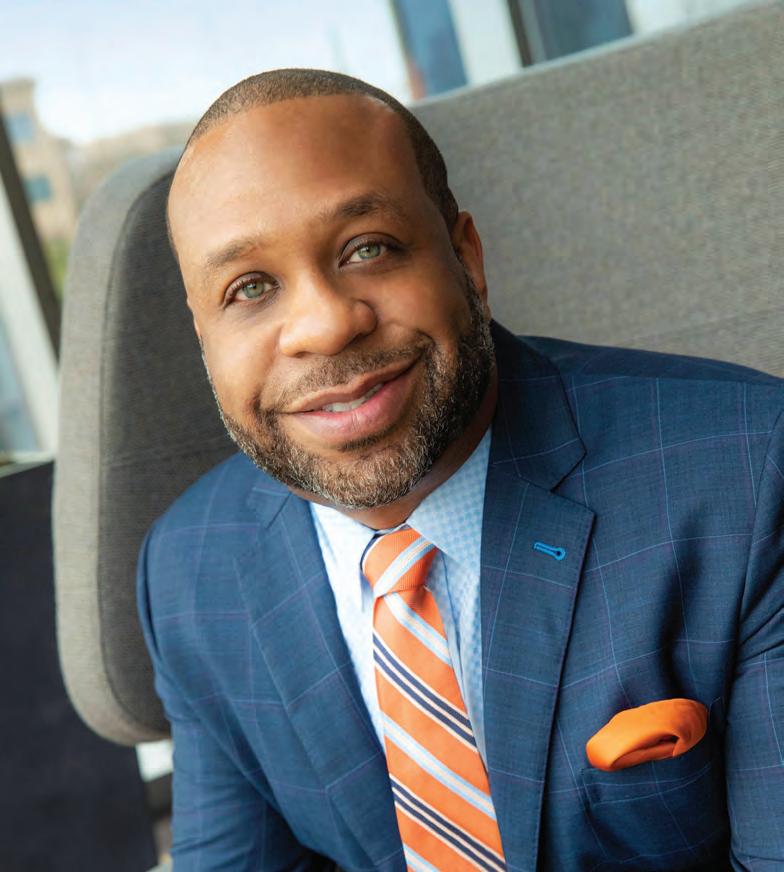


FEATURES 8 Charles Toulson, MD, MBA 24 Tom Cruise 20 Breast Cancer: Risks, Symptoms, and New Early Detection 40 History and Medicinal Effects of Laughter AND MUCH MORE... 13 No Will is Such a Bad Plan for Your Family 17 Depression, Hearing Loss, and Treatment with Hearing Aids 31 Summer Boredom Turned Into “Good Times” 48 Before, During, and After Cataract Surgery CONTENTS FOLLOW US ON SOCIAL MEDIA @ LivingWellmag @ LivingWellmags @ LivingWellmags @ LivingWellmagaz TEXOMA AREA CHARLES TOULSON, MD, MBA A PIONEER IN THE FIELD OF ORTHOPEDIC SURGERY TOM CRUISE BACK ON TOP BREAST CANCER RISKS, SYMPTOMS, AND NEW EARLY DETECTION HISTORY, SCIENCE MEDICINAL EFFECTS OF LAUGHTER Visit LivingWellMag.com for a free digital subscription. 8 24 Charles Toulson MD, MBA 20
Brian Nwannunu, MD, MS
Brian Nwannunu, MD, MS, is an orthopedic surgeon specializing in hip and knee replacement. He cares for patients at Alpha Orthopedics & Sports Medicine’s offices in Sherman and McKinney, Texas.
Dr. Nwannunu, a native of Dallas, graduated Valedictorian from the High School for Health Professions at Townview Magnet Center in DISD. He then earned his bachelor’s degree in Biology at Morehouse College in Atlanta, Georgia, where he was part of the Morehouse College Honors Program. Upon graduation, he completed his master’s degree in Physiology at Georgetown University in Washington, D.C., with a concentration on complementary and alternative medicine. Dr. Nwannunu then graduated with his medical degree from Howard University College of Medicine in Washington, D.C., where he was inducted into the Alpha Omega Alpha Honor Medical Society.
Dr. Nwannunu completed his residency in orthopedic surgery at the John Peter Smith Health Network in Fort Worth, Texas, before pursuing additional training with a fellowship in adult reconstruction at Baylor College of Medicine in Houston, Texas. In addition to his clinical training, Dr. Nwannunu enjoys mission work abroad, providing medical care and health education to populations in need.
He is a member of the American Medical Association, National Medical Association, American Academy of Orthopaedic Surgeons and the American Association of Hip and Knee Surgeons.
When not working, Dr. Nwannunu enjoys basketball, weight training, outdoor activities, attending art and music festivals, traveling, world news, and reading.


6 • JULY/AUGUST 2022
TPC Drive, Suite 116 McKinney, Texas 75070 (972) 362-0065 204 Medical Drive, Suite 110 Sherman, Texas 75092 (972) 362-0253 alphaortho.net
6850
TOP DOCS 2022 Livingwell PROVIDERS HEALTHCARE AND OTHER

Dr. Hagen helps people see; now he wants to help you hear again
Dr. Hagen is a 57-year-old optometrist who understands the value of seeing – and hearing – well. Even though he promised himself he wouldn’t be that guy who refused to get hearing help, he admitted
“My new rallying cry is to go in and have your hearing assessed!” Dr. Hagen said. “I want everybody to experience the same success that I have. Now that I see it from the patient side, it’s very powerful.”
apparent from day one. Dr. Hagen spoke enthusiastically about the technology: “Mostly I live in the PureSound setting. It makes everything feel like natural sound, sort of what I expect my hearing was like 20 years ago.”
“I love to hear! I feel like I get to participate in my world more fully than I was used to for quite some time.”

“There’s a new, advanced technology I want you to experience It’s the PURESOUND, WIDEX MOMENT hearing aids that process sound with lightning speed, and
in so you can experience it for yourself. We want you to hear well again.” - Jill Sheppard
2-Week Free In-Home Trial
a set of premium digital hearing instruments. Some restrictions apply.





TEXOMA AREA • 7 1800 N. Travis St., Suite D • Sherman, TX 75092 • 903.868.2650 800 E. California, Suite 4 • Gainesville, TX 76240 • 903.868.2650 www.hearcareinc.com It’s worth your time. It’s about your life.
Jill Sheppard, B.S., SLP/Audiology, Kenneth Sheppard, Jr., LFDHI
Bes Audiologist/ Hearing Aid Center
YOU’LL LIKE WHAT YOU HEAR!

8 • JULY/AUGUST 2022
Dr. Charles Toulson
Surgical Excellence
Renowned orthopedic surgeon Charles Toulson, MD, MBA, ensures positive outcomes.
Ctcharles Toulson, MD, MBA, is an orthopedic surgeon compelled to excel. From a young age, he realized that his aptitude for medicine could be laser focused to help people living with chronic pain.
His life is a superb example of a man with a plan—a targeted plan to become a pioneer in the field of orthopedic surgery. Board certified and fellowship trained, Dr. Toulson specialties and interests include adult hip and knee reconstruction, adult hip and knee revisions, and state-of-the-art robotic-assisted joint replacement. He’s regarded by his patients and peers as one of the leading orthopedic surgeons in the country.
Not only has Dr. Toulson performed more robotic-assisted joint replacement procedures than any other surgeon in the Dallas-Fort Worth Metroplex, he has the distinction of paving the path for two major hospitals in North Texas to achieve the elite status of being accredited as Joint Replacement Centers of Excellence.
Exceptional Education and Training
Dr. Toulson’s impeccable educational pedigree includes a medical degree from the University of North Carolina at Chapel Hill, extensive training from John Hopkins Hospital, and sub-speciality training at the Hospital for Special Surgery in New York, the number-one ranked orthopedic hospital in the country. Coupled with his MBA from Baylor University, Dr. Toulson’s education and training ensure positive outcomes.
Affiliated with several institutions in Texas including Methodist McKinney Hospital, Medical City McKinney, Medical City Frisco and Plano, Eminent Medical Center, Baylor Scott & White Medical Center–McKinney, Baylor Scott & White Medical Center–Plano and Baylor Scott, White Surgical Hospital at Sherman & Texas Health Presbyterian Hospital of Allen, his esteemed reputation is one that has been hard earned and reflects his unwavering dedication to his craft.
Alpha Orthopedics & Sports Medicine Founder
As the founder of Alpha Orthopedics & Sports Medicine, Dallas’ premier destination for hip and knee replacements, Dr. Toulson also puts his MBA from Baylor to good use. His practice has locations conveniently located in Dallas and in McKinney and provides care for a full range of musculoskeletal disorders, diseases, and injuries to the human body.
Instilled with a deep knowledge of the skeletal structure and its complicated movements, he was the first surgeon in the area to perform a direct anterior hip replacement with robotic assistance. Dr. Toulson also completed the first ever, total knee replacement for both of a patient’s knees bilaterally (simultaneously) using the MAKO Robotic-Arm Assisted Technology.
TEXOMA AREA • 9
The MAKOplasty robotic arm assists Dr. Toulson in making precise surgeries. “What’s critical is the MAKO robot will not permit me to deviate outside of the plan that we have instituted in the very beginning of surgery,” details Dr. Toulson. “As the surgeon, I’m still doing the surgery, the robot is just allowing me to do it in a more precise manner.”
“This 3D technology allows me to see the orientation, alignment, rotation, and actual size of the implant that we will be using. So, I can actually see with 3D technology what the implant looks like and I can make adjustments in surgery to balance the ligaments inside of the knee,” Dr. Toulson continues.
A Pioneer in Minimally Invasive Surgery Techniques
Known for pioneering minimally invasive surgery techniques for hip and knee replacement, including the anterior supine hip replacement surgery. Dr. Toulson’s anterior approach allows patients to immediately bend their hip freely and bear full weight after surgery because he’s able to replace a hip joint without detaching muscle from the pelvis or femur during surgery.
Resulting in rapid recovery times for patients, the anterior approach allows patients to walk without a cane or walker in just one to two days following surgery, according to Dr. Toulson.
Successful Outcomes
Dr. Toulson details two patient outcomes that stand out as accomplishments, although he has a plethora of patients with positive outcomes eager to share their stories. In fact, all of his patients have confidence in Dr. Toulson’s experience and knowledge. This includes treating patients like an allergy nurse in a busy ENT practice in McKinney. Working over 10 hours a day providing allergy skin testing and giving allergy shots, the constant daily up and down movement performing his job caused the nurse excruciating hip pain. Enter Dr. Toulson who performed a total hip replacement that eliminated the pain.
“My wife and I cannot begin to find words to express our gratitude for your quick diagnosis and subsequent surgery to put my life back on track,” the nurse wrote Dr. Toulson. “I’m proud to personally add my name to the list of the many positive reviews I initially read about describing your clinical and personal skills in action.”
Another patient was suffering with severe arthritis in her knees and also sought out Dr. Toulson for relief. “I was having severe pain in my knees, I had difficulty going up and down stairs, steps, even the curb. It hurt so bad to walk, even short distances,” she says.
“When patients come in with arthritis, we often try non-operative means of treatment before we talk about surgery,” says Dr. Toulson. Once non-operative options for knee arthritis are exhausted, Dr. Toulson sits down with patients and details the benefits and the risks of total knee replacement.
The astounding results of this patient’s duel knee replacement surgery were life changing. “The surgery went wonderfully. I haven’t had any problems and every day it gets better and better. I can walk up the steps now getting into my home,” she says.
Highlights of Dr. Toulson’s countless other success stories and the joy his patients express at the outcome of their hip or knee replacement surgeries—and how it’s changed their lives—are documented on his website, drcharlestoulson.com, with videos and moving testimonials.
Awards and Accolades
It’s no surprise that Dr. Toulson has been named among the Best Doctors in Dallas for orthopedic surgery by D Magazine nine times and among the Best Orthopedic Surgeons in Collin County by D Magazine six times. He’s also been awarded best orthopedic surgeon for nine years running by Living Magazine, along with being named best orthopedic surgeon for the past five years by LIVING WELL Magazine.
A Personal Glimpse of Dr. Toulson Outside of His Practice
Dr. Toulson is among those extraordinarily rare individuals whose medical skills are only outmatched by his compassion and kindness. He greets every patient with a warm smile and considers each one of them part of the family.
Speaking of family, Dr. Toulson’s immediate loved ones include his lovely wife Deryn Toulson. Deryn holds a bachelor’s degree in nursing and works at Medical City McKinney Hospital. A former cheerleader for the New Orleans Saints, she wed Dr. Toulson in a fairytale Dallas ceremony in 2017. The couple’s three adorable children—Cameron, Brooklyn, and Blade—make Dr. Toulson beam with pride.

10 • JULY/AUGUST 2022
TOP DOCS 2022 Livingwell PROVIDERS HEALTHCARE AND OTHER

Asthesurgeon,I’m stilldoingthesurgery, therobotisjust allowingmetodoitin amoreprecisemanner.
The MAKOplasty® robotic arm assists Dr. Toulson in making precise surgeries.


12 • JULY/AUGUST 2022 903.813.8500 805 North Travis Street Sherman Texas 75090 Certified As An Elder Law Attorney by The National Elder Law Foundation As Recognized by the Texas Board of Legal Specialization CraigWatsonLaw.com state Tax Planning - Wills, Living Trusts, Asset Protection, Wealth Transfer Planning Elder Law - Nursing Home Medicaid Quali cation Probate, Guardianships, Will Contests & Probate Litigation Corporations, Partnerships, LLCs, LLPs Business Law - Ownership Succession, Sales & Purchases of Companies Over 25 Years of Experience Craig W. Watson ATTORNEY AT LAW Craig W. Watson o ers years of experience combined with a current knowledge of the rules of law that govern situations a ecting us as we grow old, or nd ourselves managing the a airs of a parent or other relative.
No Will is Such a Bad Plan for Your Family…
By CRAIG WATSON
Jane Doe, age 54, was tired. “I’m going to bed early tonight,” she told her husband. They had been happily married for 14 years. John was sitting in his recliner watching television. It was not unusual for him to fall asleep watching TV. Jane got up the next morning and quietly got ready for work. As she was walking past John, she noticed something did not look right. She walked closer and tried to wake him. John had died in his sleep without warning. He had been the picture of health; he worked outside, was not overweight, never smoked, and never went to the doctor. “What a nightmare,” you say; and, it is. You will really think ‘nightmare’ when you hear about his estate.
John did not have a Will or any life insurance. John and Jane did not have a prenuptial or postnuptial agreement. Self-employed, he had a lot of debt, including equipment loans, car loans and credit card balances. Jane knew virtually nothing about John’s business. John owned their house before they got married so the house was his separate property. Most of his net worth was tied up in the house, which was worth $350,000. The remaining mortgage balance was $150,000. He had a savings account of approximately $18,000. John’s first wife remarried a wealthy man who adored John’s teenage daughter so she had everything she needed. They live on the West Coast, so John might have seen his daughter once per year for the last several years. John’s daughter decided to hire her own attorney to represent her interests in John’s estate.

Will takes longer because more court hearings are required. So, all of the loans will soon be three payments behind, resulting in unpleasant calls from collection agencies. John still owes child support to his first wife. Before any inheritance can be distributed to Jane or John’s daughter, the debts and expenses must be paid. Jane finds that after expenses, she will inherit nothing from John’s personal property.
Because John died without a Will, the Texas heirship statutes control who inherits his property. John’s personal property (cash, personal effects, brokerage accounts, equipment, cars, etc.) will be split equally by Jane and John’s daughter. However, there is no equity in his equipment because the loans are about equal to the value of the equipment securing the loans. The cash will quickly be eaten up by the funeral, appraisal fees, attorney fees, monthly debt payments, property taxes, insurance, and other expenses. Much to Jane’s surprise, she learned that because John died without a Will, his daughter’s attorney can ask for John’s estate to pay his attorney fees and the judge might allow the request.
Of course, the estate’s attorney will also be paid out of the estate. Legal fees are much higher for an estate without a well-drafted Will because the attorney must do a lot more work. Property taxes are due on the house. Within a month of John’s death, the equipment loans, car payments, house payment and credit cards are all one month overdue, meaning two payments are due. Probating an estate without a
Because the house was John’s separate property, John’s daughter will inherit two-thirds of the house. Jane will only inherit the right to live in the house but the daughter inherits the entire house as soon as Jane dies. However, in order to live in the house, someone has to pay the monthly mortgage of $1,200. Jane only earns $22,000 per year at her job. The property taxes and homeowner’s insurance are $8,000 per year. Living in the house is not an option for Jane because she simply cannot afford it. Jane is devastated to learn that she will inherit very little from John’s real property. So when all the dust settles, John’s pampered daughter inherits most of his estate.
In conclusion, if you do not plan for the disposition of your estate, Texas law provides an inflexible and often surprising “estate plan.” This is especially true in second marriage situations. Your very own well-drafted estate plan can protect your loved ones from extra expenses, avoidable delays, preventable disputes and devastating surprises—much like homeowner’s insurance protects you in case your house burns down. Hopefully, you will never need your homeowner’s insurance. Unfortunately, everyone will need an estate plan someday. Because John never got around to it, Jane was left with virtually nothing, a result that John probably never intended. Don’t let such a depressing experience happen to you or your loved ones. Make sure your family is prepared and secure.
TEXOMA AREA • 13
Caring for patients. Supporting their families.

JUST BECAUSE DAYS ARE LIMITED, QUALITY OF LIFE SHOULDN’T BE.
We are your neighborhood hospice helping patients and families find loving care with unparalleled skill. Surprisingly, perhaps, there are still opportunities to experience joy. Governed by community leaders, funded by grants and gifts, we are an award-winning hospice, providing end-of-life care for you and support for those you love. Let us be of assistance during this time when every moment is more precious than ever.

Hospice Care

Palliative Supportive Care

Grief and Loss Programs

Emotional and Spiritual Support

Supporting your choices for end-of-life care

Comprehensive, compassionate services to meet your needs

Care for your family




14 • JULY/AUGUST 2022 316 S. Chestnut Street Gainesville, TX 76240 (940) 665-9891 505 W. Center St. Sherman, TX 75090 (903) 868-9315 A 501(c)(3) non-profit community-based organization since 1982 www.HomeHospice.org
Be understood, valued and reassured at
“Life has its ups and downs, its predictability and surprises. We help clients develop a sound investment plan based on what they tell us is important to them, carefully considering their goals, timeframe, risk tolerance, and management of their assets. By offering consistent communications and being readily accessible, we assist them with staying the course toward their financial objectives – in good times and challenging ones.”
Juston Dobbs, MBA, CDFA®, CFP®, Managing Director –Investments at Dobbs Wealth Management Group of Wells Fargo Advisors in Sherman

The Forbes Best-in-State Wealth Advisors ranking algorithm is based on industry experience, interviews, compliance records, assets under management, revenue and other criteria by SHOOK Research, LLC, which does not receive compensation from the advisors or their firms in exchange for placement on a ranking. Investment performance is not a criterion.

J. Dobbs, MBA, CDFA®, CFP® Managing
TEXOMA AREA • 15 600 E. Taylor St. STE 1000 • Sherman, TX 75090 • 903-893-6682 • www.justondobbs.com
Director -
Focusing on Your Goals, Your Family, Your Future
Juston
Investments
Dobbs Wealth Management
of Wells Fargo Advisors
Group
The use of the CDFA® designation does not permit Wells Fargo Advisors or its Financial Advisors to provide legal advice, nor is it meant to imply that the firm or its associates are acting as experts in this field. Wells Fargo Advisors is a trade name used by Wells Fargo Clearing Services, LLC, Member SIPC, a registered broker-dealer and non-bank affiliate of Wells Fargo & Company. CAR #0522-02239 Investment and Insurance Products: NOT FDIC Insured / NO Bank Guarantee / MAY Lose Value
Juston Dobbs & Amber Dobbs with Gauge Dobbs Wealth Management Group of Wells Fargo Advisors

» Staffed by 2 Licensed, Doctors of Audiology
» Hearing Aid Fittings, Maintenance and Repairs
» Invisible Fittings/Open Fittings
» Evaluation Period On All Hearing Aids
» Hearing Evaluations For All Ages
» Wireless/Connectivity Hearing Solutions
» Battery Purchase Programs
» Custom Ear Protection
» Assistive Devices

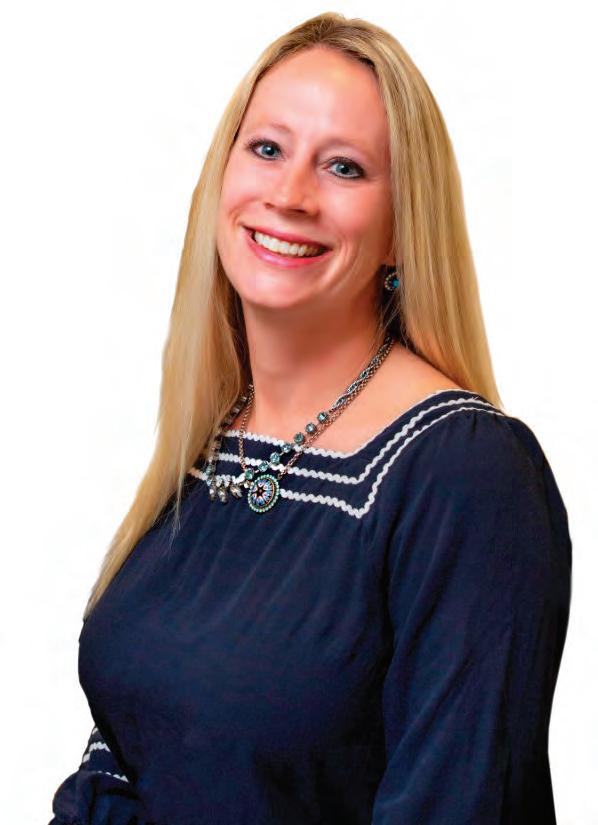

16 • JULY/AUGUST 2022
4201 Medical Center Dr, Suite 270 Across from Medical City of McKinney Mon-Fri: 8:30am-5:00pm Other times available by appointment Locally Owned and Operated • Financing Options Available hearinmckinney.com 972.838.1300 HEARING SERVICES OF McKINNEY CASSANDRA WILSON, Au.D. DOCTOR OF AUDIOLOGY Better Hearing KEEPS YOU Connected!
Depression, Hearing Loss, and Treatment with Hearing Aids
Courtesy HEARING SERVICES OF McKINNEY

Around the beginning of the 21st century, there were a half-dozen landmark studies about the relationship between untreated hearing loss and other health related issues. All which led to the insights about the possible benefit of hearing aids and aural (hearing) rehabilitation.
A review of the literature suggests complex but compelling association between hearing loss and depression. One study was done at the University of Texas Health Science Center in San Antonio in collaboration with a VA clinic. This study found of 194 hearing impaired participants (half of which were assigned to a waiting list group, therefore not receiving any hearing aid treatment; the other half were fit with hearing aids). Before the study began, 82% of subjects reported adverse effects of the quality of life due to hearing loss and 24% were depressed.
At a four-month follow up, the group that was treated with hearing aids showed significant score improvements for social and emotional function, communication function, cognitive function, and lessening of depression. This field trial established that hearing aids are a successful treatment for reversing social, emotional and communication dysfunctions caused by hearing loss. Additionally, it suggested that hearing aids may lead to improvements in cognition and depression. Two years later the study continued to show in 192 of the same participants, the quality-of-life benefit measures for social and emotional, communication, and depression were sustained.
Another significant study was the 1999 National Council on the Aging (NCOA) report on “The Consequences of Untreated Hearing Loss in Older Persons.” In a large-scale national survey of older Americans, the study quantified the social, psychosocial, and functional effects of hearing loss, with the goal of assessing the effects of hearing loss on quality of life and comparing these effects to those who wear or do not wear hearing aids. This cross-sectional, self- assessment survey was comprised of 2,304 hearing impaired individuals and 2,090 family members. The study concluded:
“Most users of hearing aids reported significant improvements in the quality of their lives since they began to use hearing aids. Half or more reported better relationships at home and improved feelings about themselves. Many also reported improvements in their confidence, independence, relations with children and grandchildren and view about life overall. Along every dimension, family members of the
hearing-impaired person were even more likely to report improvements. The majority of family respondents reported that use of hearing aids had resulted in improvements in terms of relations at home, feelings about themselves, life overall, and relations with children and grandchildren.”
In 2003, a review was published of all the studies done to date on the negative consequences of uncorrected hearing loss in the International Journal of Audiology. The findings were that uncorrected hearing loss represents an auditory disability involving reduced speech recognition ability, especially in difficult listening environments and reduced ability to detect, identify, and localize sounds. It was stated that this affects the lives of both the hearing-impaired person and significant others and that the hearing-impaired person may not always be aware of the consequences. It was also stated that uncorrected hearing loss gives rise to a poorer quality of life, related to isolation, reduced social activity, a feeling of being excluded, and increased symptoms of depression. The 14 major risk factors for depression are: alcohol dependence, anxiety, chronic pain, comorbid chronic medical conditions (hearing loss), female gender, hypomania or mania, nonresponsive to effective treatments for medical conditions, obstetric patients, psychosis, personal or family history of depression, recent childbirth, recent stressful events, substance misuse, and unexplained somatic symptoms.
Hearing loss has been associated with a dozen comorbidities, of which four were also significantly associated with the risk of depression-chronic artery disease, alcohol-related illness, anxiety, and stroke.
We think of the obvious effect of hearing loss with regard to communication difficulties. However, your hearing health contributes to your overall well-being and quality of life. Statistically, hearing loss is the third most prevalent chronic condition in older Americans after hypertension and arthritis. Aging also brings cognitive processing deficits that interfere with communication and can create distractions that lead to memory loss, falls, and other accidents. If hearing loss is strongly associated with depression, then, are hearing aids a possible method for treating depression in this population?
To hear better, is to live better! Start a better health and wellness conversation today! Better hearing health is possible! Call your audiologist today!
TEXOMA AREA • 17
“In
 Charles Dannel
Charles Dannel

18 • JULY/AUGUST 2022 Take care of your family. We’ll take care of everything else. 302 S. Walnut Street • Sherman, TX 75090 • 903.893.1171 • www.dannelfuneralhome.com Dannel Funeral Home is owned by Charles Dannel, fifth generation exemplifying leadership and community service.
addition to honoring loved ones, funerals help meet the family’s emotional and spiritual needs. We focus on their wellbeing, giving them the opportunity to plan in a relaxed, comfortable environment. A thoughtful funeral service gives families the best possible beginning to healing, so they can move forward. There are so many ways to make funerals meaningful. It’s our privilege to be of service.”









TEXOMA AREA • 19 Healing and Care in a Beautiful Environment 3515 Park Avenue Denison, TX 75020 903-327-8537 903-327-8794 (Fax) 999 Raintree Circle Allen, T X 75013 972-390-8088 866-574-1006 (Fax) THE BELMONT AT TWIN CREEKS • ALLEN, TEXAS by CANTEX CONTINUING CARE NETWORK www.cantexcc.com “Where we are committed to excellence” 1400 Black Hill Drive Gainesville, TX 76240 940-665-5221 866-660-7907 (Fax) RENAISSANCE CARE CENTER by Cantex Continuing Care Network Cantex Continuing Care Network is committed to providing the highest level of services to promote recovery and restore independence. We are passionate about patient safety and well-being, devoted to innovation, and dedicated to values of compassion and service.

BREAST CANCER
RISKS, SYMPTOMS, AND NEW REVELATIONS ON EARLY DETECTION
By KIMBERLY BLAKER
Twelve percent of women today will develop invasive breast cancer, and more than 40,000 will die from it this year alone, reports BreastCancer.org. That’s why a refresher course on early detection and staying up to date on the latest studies is essential and the reason for October’s Breast Cancer Awareness Month.
20 • JULY/AUGUST 2022

Mammography often doesn’t detect the more lethal types until they’re in the later stages.
Risk factors
There are several risk factors for breast cancer, as identified by the American Cancer Society (ACS). Some of these are unchangeable but should be taken into account in developing a screening plan. Other risk factors are lifestyle related. Therefore women, especially those already at higher risk, should consider those factors she can control.
Still, the simple presence of risk factors doesn’t mean you’ll go on to develop breast cancer. Likewise, a lack of risk factors doesn’t mean you won’t develop the disease. For this reason, all women should be aware of the risks and symptoms and what screening does and doesn’t do.
Some factors that are unchangeable and increase risk are female gender, aging, genetics, and race and ethnicity (white women are at slightly higher risk) according to the ACS. A greater number of menstrual cycles, previous chest radiation, and exposure to the drug diethylstilbestrol (DES) also puts women at a slightly higher risk.
Other risk factors can often be controlled. Pregnancy and childbirth are some of these factors. According to the National Cancer Institute (NCI), women who had more than one child have increased protection with each successive birth.
Women who breastfed also have reduced risk of breast cancer, the NCI explains. The longer the total length of time spent breastfeeding during the child-rearing years, the greater the protection.
Oral contraceptives, according to the ACS, slightly increase risk. Though once a woman is off contraceptives for 10 years, that risk is no longer present.
Hormone therapy for menopausal women can also increase risk. The ACS says estrogen alone is not a concern. For certain women, it can even slightly reduce the risk. But estrogen combined with progestin can increase risk.
Another risk factor is alcohol. Having one daily drink increases the risk only slightly, while the greater the consumption, the higher the risk. More than five drinks daily increase the risk for other cancers as well.
After menopause, being overweight or obese increases risk, says the ACS. But as the organization explains, the risk of breast cancer related to weight is complex. Those who were overweight as a child may not be affected. The distribution of excess body fat may also play a role. Waist area fat, in particular, might be more significant in increasing risk than fat in other parts of the body such as hips and thighs.
Exercise, however, has been shown to decrease risk, according to a study by the Women’s Health Initiative. It found just 1.25 to 2.5 hours of brisk walking each week can reduce risk by 18%.
Several factors that previously have been claimed to increase risk factors are now disproven or deemed highly improbable, according to ACS and Memorial Sloan Kettering. These include antiperspirants, bras, abortion or miscarriage, dense breasts, fibrocystic disease, and breast implants.
Factors that remain unclear because studies have produced conflicting results include diet and vitamins, environmental chemicals, tobacco smoke, and night work. These factors require further research to determine if there’s any relationship.
Continued on page 22










Symptoms
















There are several signs to watch for that might be indicative of breast cancer. Though most of these symptoms could be caused by something else such as caffeine, menstrual periods, infection, or other illness or factors. If you notice any of these symptoms, see your health care provider to rule out breast cancer. Symptoms to watch for, say ACS and other breast cancer organizations, include:
• A new lump or breast change that feels different from the rest of your breast
• A new lump or breast change that feels different from your other breast
• You feel something different that you haven’t felt previously
• Nipple discharge that occurs without squeezing the nipple
• Nipple discharge that occurs in only one breast
• Bloody or clear discharge, rather than milky
• Thickening, a lump or hard knot inside the breast or in the underarm area
• Breast swelling, warmth, or redness
• Change in breast shape or size
• Breast skin dimpling or puckering
• A sore or rash on the nipple, particularly scaly or itchy
• Your nipple or other parts of your breast pulling inward
• Sudden nipple discharge
• Pain in one spot that doesn’t go away
TEXOMA AREA • 21
Early detection and screenings
Screenings are an essential means for detecting breast cancer, hopefully in its early stages. Until more recently, women were encouraged to do a monthly self-examination. But a major study reported in The Journal of the National Cancer Institute in 2002, concluded self-examination has played no role in improving cancer detection. It also found the extensive teaching of self-examination leads to an increased rate of benign breast biopsies.
Clinical breast exams, however, are still recommended. Beginning at age 40, clinical exams should be done annually. Women with higher risk factors should have exams more often and consult with their doctor for the recommended frequency.
Mammography, believed to be one of the most crucial tools in early detection for decades, first started in the 1960s. Early trials found mammography reduced breast cancer death rates by 25%.

But Peggy Orenstein points out in her 2013 New York Times article, “The Feel-Good War on Breast Cancer,” such statistics have overstated mammography’s role in the reduction of breast cancer death rates. This is because the increased use of mammograms occurred along with much-improved treatments. Medical experts now believe treatments likely played a more significant role in reducing deaths.
For this reason, mammograms have come under fire in recent years as more studies have revealed the debatable usefulness of this screening technique, at least for younger women. That’s because breast cancer and detection are more complex than once understood to be.
It’s now known there are at least four types and subtypes of breast cancer. Mammography often doesn’t detect the more lethal types until they’re in the later stages. Add to this, mammograms result in significant overdiagnosis leading to unnecessary treatment. This comes with its own risks.
Doctor Deanna Attai, president of the American Society of Breast Surgeons, explains, “Ductal carcinoma in-situ [DCIS] is also referred to as noninvasive, or Stage 0 breast cancer. It is primarily diagnosed by screening mammograms, as it often does not form a palpable lump. DCIS accounts for approximately 20% of mammographically detected breast cancers. As screening mammography has become more prevalent, the rate of DCIS detection has increased.”
Some medical experts say DCIS is really not a form of cancer at all. Referring to it as such results in overly aggressive treatment.
The likelihood of low-grade DCIS developing into invasive breast cancer is only 16%, says Dr. Attai. While high-grade DCIS has a 60% chance over 10 years. The problem is there’s currently no way to determine which cases of DCIS will ultimately develop into breast cancer. This creates a significant dilemma.
Still, what is known is among women in the United States, breast cancer is the second leading cause of cancer deaths. Various studies
indeed reveal mammography screening seems to have very limited usefulness among women under 40. Still, it’s moderately effective for detection in women ages 40-49 and is most useful for those in the 5069 age group.
The results of recent studies have, therefore, revealed several needs. First, more research is needed to better answer questions about the approach to both detection and treatment. Additionally, better screening techniques should be developed for detecting the more deadly forms of breast cancer.
Currently, there’s much debate among medical and cancer organizations regarding the recommended frequency of mammography, particularly among women ages 40 and up. These various organizations point to different studies coming to different conclusions about mammography’s safety and effectiveness.
The latest cancer screening guideline by the ACS (2015) recommends women with average risk should begin regular mammography screenings at age 45. Then they should be annually screened until they reach 54. After that, they should transition to every two years, as long as they’re in good health with a life expectancy of at least 10 years.
The American College of Physicians (ACP) has done a rigorous analysis of numerous studies and the guidelines of several organizations. The ACP says the methodology used by several organizations in determining guidelines isn’t sound. The organizations that scored highest for the use of sound methods include the ACS, World Health Organization, The Canadian Task Force on Preventive Health Care, and the U.S. Preventive Services Task Force.
Finally, there’s no one-size-fits-all plan that works best. So, mammography screening for breast cancer should be based on informed decisions and individualized plans. It should take into account a woman’s age, risk factors, and both the advantages and disadvantages of mammography for each woman’s unique circumstances.
22 • JULY/AUGUST 2022
Continued from page 21

DENNIS BIRENBAUM, MD


Dr. Birenbaum founded the Arlington Cancer Treatment Center in 1981. He founded the Texas Hematology/Oncology Center, PA in 1997. He is the founder, Medical Director, and CEO. Dr. Birenbaum trained at The University of Texas M.D. Anderson Cancer Institute for 5 years, 3 years as a Hematology/Oncology fellow and 2 years as a facility professor. His private practice in Hematology/Oncology has been in the Dallas/Fort Worth area since 1979. Dr. Birenbaum is available by cell phone 24/7 and participates in many support groups and radio programs.
AREAS OF CLINICAL INTEREST:
• Gastrointestinal Tumors
• Melanoma, Sarcoma
• Breast Cancer
• Lymphoma
• Kidney Cancer
EDUCATION AND TRAINING CREDENTIALS:
• Southern Methodist University
• Universidad Autonoma de Guadalajara/University of Michigan
• Straight Medical Internship - Henry Ford Hospital/University of Michigan
• Straight Medicine Residency - Tulane University Medical Center/Ochsner Clinic
• Fellowship Hematology/Oncology - University of Texas M.D. Anderson Hospital and Tumor Institute
• Private Practice 1979 to Present
PERSONAL INTERESTS:
• Born and raised in Dallas, TX
• Father of 2 sons
• Owns six dogs
• Loves traveling and golf
• Avid collector of arts and antiques
Dennis Birenbaum, MD and Dr. Wyszynski, MD, DO are M.D. Anderson trained hematologists/oncologists.
Dr. Wyszynski, MD, DO also trained at Fox Chase Cancer Center in Philadelphia, PA.
EUGENE J. WYSZYNSKI, DO
Dr. Wyszynski joins the Texas Hematology and Oncology Centers after many years of successful private medical practice in the Dallas/Fort Worth area. Dr. Wyszynski completed his internship and residency at John F. Kennedy Memorial Hospital in Stanford, New Jersey. He followed these with a number of Fellowships including one in Hematology/Oncology at the prestigious M.D. Anderson Cancer Center in Houston, TX, and two years at Fox Chase Cancer Center in Philadelphia, PA. Dr. Wysznski is well known for his quality of care and the personal interest he takes in his patients. He is very active in many professional societies and investigative trials.
BOARD CERTIFICATIONS:
•American Osteopathic Board of Internal Medicine: Hematology/
•Oncology-Certified: 8/24/2007
•American Osteopathic Board of Internal Medicine
PROFESSIONAL SOCIETIES:
•American Osteopathic Association
•ASCO
•Texas Medical Association
•Dallas County Medical Association
CLINICAL CANCER INVESTIGATIVE TRIALS:
• Central Pennsylvania Oncology Group Protocal
• Eastern Cooperative Group
• Southwest Oncology Group
PERSONAL INTERESTS:
• Married and father of 2 children
• Enjoys traveling and spending time with family
• Active in many hobbies

TEXOMA AREA • 23
know
THOC doctors don’t want to learn on Monday that you had a problem on Friday. They want to
Friday. They are available to you 24/7.
Texas Hematology/Oncology Centers 12700 Hillcrest Road Dallas TX 75230 469-453-5500 We accept all insurance: Private, Medicare, Medicaid, Medicaid HMO, and VA. www.thocpa.com @thocCares
You may find that your 2nd or 3rd opinion should have been your first.

SET TO Cruise
THE WORLD’S BIGGEST ACTION HERO IS BACK WITH A NEED FOR SPEED.
• BY SONDRA BARR •
Tom Cruise returns to top form as the world’s number one action hero. His latest film, Top Gun: Maverick, raked in a record-breaking $157 million its opening weekend and continues to lure people into theaters with high-intensity aerial footage, nostalgia, and the reemergence of Pete ‘Maverick’ Mitchell (aka Tom Cruise, in full beefcake glory).
A testament to his enduring movie magic, the popularity of the film is especially epic considering Cruise is pushing 60 and still committed to doing his own stunts—flying included.
“The P-51 Mustang you see in the movie is actually my plane, so I got to pilot in those sequences,” he said to Hello Magazine. “I also got to be in the jet fighter a lot more this time, which was thrilling.”
A skilled aviator, to kick off the Top Gun: Maverick premier at the USS Midway in San Diego, Cruise arrived in dramatic fashion piloting his own helicopter to meet awaiting fans.
The film has generated glowing reviews, with many saying the film is better than the 1986 original, as is its star. “If anything, he’s more chiseled and iconic than he was in 1986,” said critic Ty Burr.
This bright moment is an enviable one for Cruise, who’s had his share of bad press. While his acting rarely misses the mark, Cruise’s personal life was tabloid fodder for years. From his Scientology ties, lambasting the use of antidepressants to Matt Lauder on the Today show, to jumping on Oprah’s couch declaring his love for now ex-wife Katie Holmes, Cruise has come across as unhinged more than once.
Yet when it comes to acting, Cruise is the consummate professional. In the 36 years it’s taken to bring the Top Gun sequel to theaters, Cruise has honed his craft to a finely sharpened edge. The worldwide gross of his more than two dozen movies is well over $8 billion and guaranteed to climb with his upcoming movie, Mission: Impossible – Dead Reckoning – Part One
Not bad for a kid who grew up dominated by a father he coined “a merchant of chaos.” In an interview with Parade, Cruise detailed his troubled childhood.
“He was a bully and a coward,” said Cruise. “He was the kind of person where, if something goes wrong, they kick you. It was a great lesson in my life—how he’d lull you in, make you feel safe and then, bang! For me, it was like, ‘There’s something wrong with this guy. Don’t trust him. Be careful around him.’ There’s that anxiety.”
Born Thomas Cruise Mapother IV, Cruise spent his formative years moving from place to place while his father searched for work.

I WOULD GO TO BED AT NIGHT FOR DECADES FIGURING OUT––HOW COULD I DO IT? HOW COULD I MATCH THIS? WHAT WOULD THAT BE?
“I had no really close friend, someone who understand you. I was always the new kid with the wrong shoes, the wrong accent. I didn’t have the friend to share things with and confide in.”
Cruise says he was bullied regularly in the 15 different schools he attended in 12 years. And, being diagnosed with a reading disability at 7 didn’t help matters. “They said, ‘Oh, he’s dyslexic.’ I’m labeled. It instantly put me into confusion. It was an absolute affront to my dignity,” said Cruise.
Watching his mother navigate the tough times and work hard to support Cruise and his three sisters inspired him to pursue his dream of acting.
Rather than attend his high school graduation, he went to Manhattan in 1980 with the goal of making it as an actor within a decade. In typical Cruise style, in less than 12 months, he was in the film Taps, followed by his breakout roll in Risky Business two years later.
In 1986, Top Gun made Cruise a superstar. He’d go on to star in a slew of hits including Rain Man, Born on the Fourth of July, A Few Good Men, Jerry Maguire, and the Mission: Impossible franchise. But, it’s the release of Top Gun: Maverick that holds a special place in his heart, which is why it took so long to get the film made.
“I would go to bed at night for decades figuring out—how could I do it? How could I match this? What would that be? So interestingly enough, artistically I thought, ‘This is really a tremendous challenge’—and that appealed to me,” he said.
“I was always thinking of the technology, how it would evolve to be able to give the audience that kind of experience. And everywhere around the world they wanted to see this movie,” he told Beverly Hills Magazine. “And finally, the story came together and technically the things that I felt we could get to an audience, a global audience, was something that I thought, ‘Ok, well, if we’re going to go in, we’re going to go in now.’”







26 • JULY/AUGUST 2022
Rain Man (1988); Photo Courtesy United Artists
Mission: Impossible II (2000); Photo Courtesy Paramount
Edge of Tomorrow (2014); Photo Courtesy Warner Bros.
Courtesy
Mission: Impossible-Fallout (2018); Photo
Paramount






To make the movie as realistic as possible, Cruise insisted that the cast train as pilots able to withstand and recreate the rigors associated with flying F-18s. “And I had to sit down when we were hiring the actors, I said, ‘We’re going to teach you how to become a pilot’ and I had to teach the pilots how to become filmmakers also,” explained Cruise. “Because when you’re up there, you’ve got to know what shots are going to look good when you’re flying and also the actors have to give performance.”
According to Men’s Health, Cruise personally designed a rigorous monthlong program that introduced his co-stars to different jets and instructors as they learned to fly and slowly built up their g-force tolerance. The aspiring aviators eventually had to sustain up to eight g’s, or around 1,600 pounds of pressure. The cast filled out daily forms for Cruise to review until they were ready for real Navy pilots to take them up in F-18s equipped with six IMAX-Quality cameras.
Capturing lighting in a bottle for a second time is never easy, especially with the added difficulty of a pandemic. The film’s release was delayed multiple times. Cruise telling his Top Gun co-stars, “I’m sorry guys, we’ve gotta do it, this is for the big screen, we’ve got to hold it.”
Seeing the movie in a theater with full surround sound brings the action to life and validates Cruise’s decision to postpone the release. It also cements another milestone for Cruise, who worked closely with the Navy to get the film made.
“I was honored with becoming the 38th civilian to be an honorary naval aviator. They gave me that commission. I was very touched by that, to have that. And also, TOPGUN school gave me a plaque that only the TOPGUN graduates get, certain pilots get,” said Cruise about the debt he owes to the Navy.
“Look, I’m fortunate, I’m lucky. This is my dream. I’ve wanted to make movies since I was four-year-old and I’m lucky, I’ve spent my life on movie sets and travelling the world, which is what I always wanted to do,” he said to Beverly Hills Magazine. “I wanted to travel the world and be part of different cultures and celebrate them and have that experience. So this is not work—this is living the dream.”
I’M SORRY GUYS, WE’VE GOTTA DO IT, THIS IS FOR THE BIG SCREEN, WE’VE GOT TO HOLD IT.
TEXOMA AREA • 27
Maverick (2022); Photo Courtesy Paramount
Cocktail (1988); Photo Courtesy Touchstone
Mission:
The Last Samurai (2003); Photo Courtesy Warner Bros.
Impossible-Rogue Nation (2015); Photo Courtesy Paramount


28 • JULY/AUGUST 2022 It’s your move. Speak with a surgeon to see if Mako Technology is right for you. Find a surgeon today! Call 1 888 STRYKER (1 888 787 9537) or visit dfwmako.com. All surgery carries risk. See your orthopaedic surgeon to discuss your potential benefits and risks. Not all patients will have the same post-operative recovery and activity level. Individual results vary. MKOSYM-PM-14_22150 Take control of your joint pain Mako Robotic-Arm Assisted Technology, the latest in total hip, partial knee and total knee replacement, is now available in your area.
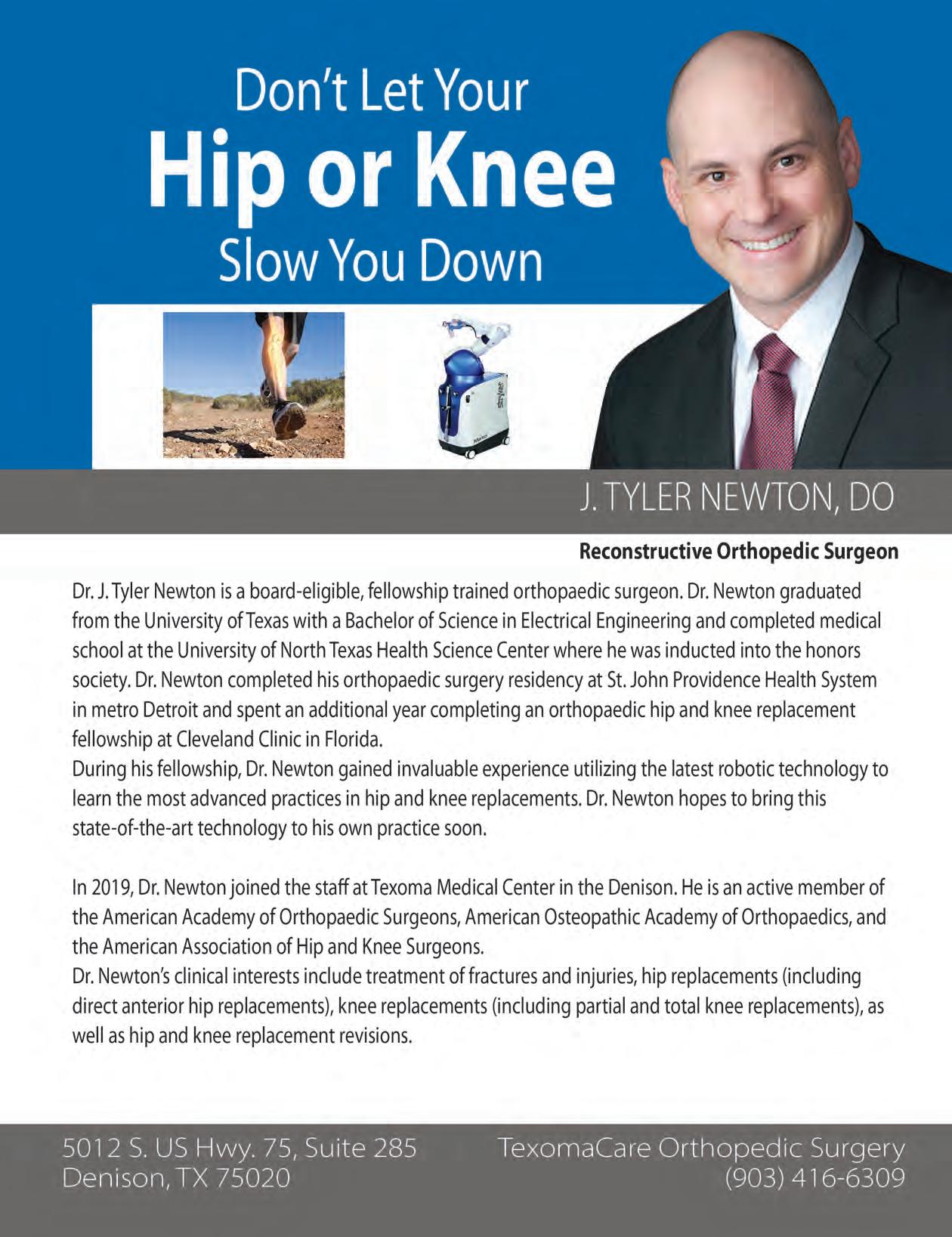


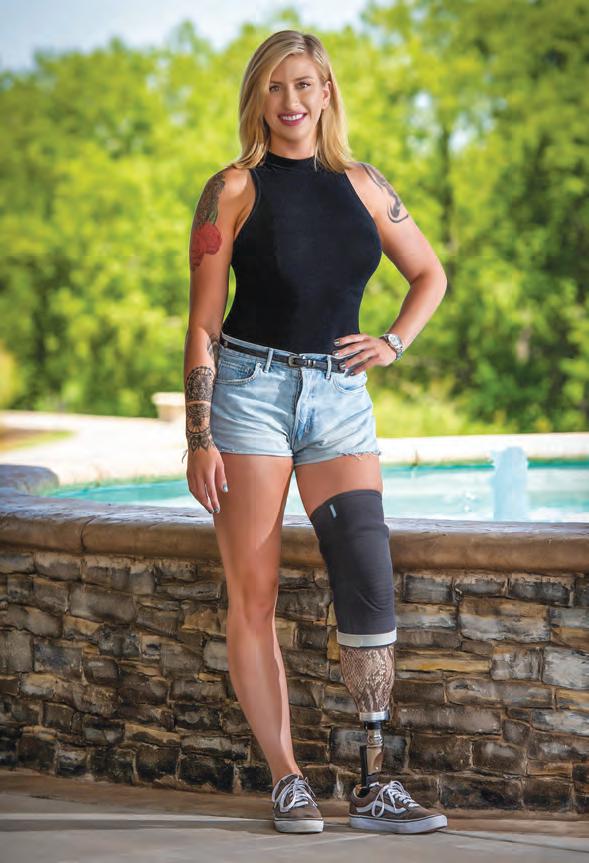
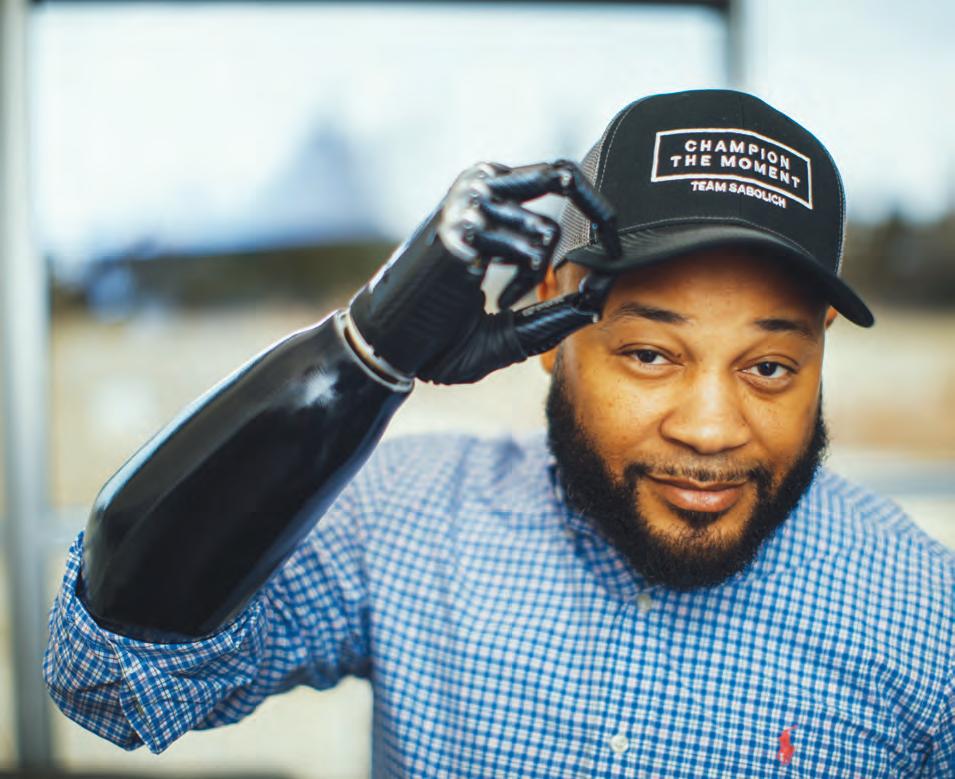


Actual Patients Experience The Sabolich Difference TheWorldLeaderinProstheticsSince1947.•Free DVD •Free Book •Free Evaluations & Second Opinions •Unmatched Patient Care and Expertise 1500 Preston Rd. Dallas, TX 75248 (877)226-5424 ScottSabolich.com
Summer Boredom Turned Into “Good Times”
By GEORGIA SMITH-LYLE, MA
Licensed Professional Counselor-Supervisor
When my three children were young, I would think about the upcoming summer and what activities we could do. Thoughts like, “How do I prevent them from being bored?”
The truth is summer boredom is not all bad! Psychologically, if a child is not bored and always given activities, they may never know their likes and dislikes. Children need to experience a bit of boredom to venture out and realize what is enjoyable to them. Being entertained all summer could be wasting their creativity and exploration. Entertaining them constantly will also cause parents to burn out before the summer is over. Parents or caregivers should provide options for children to choose from. It is also healthy for children to have balance in their activities where they are not constant “fun” consumers, but are also building responsibility in doing chores, with rewards, and volunteering to help others.
Summer is an opportunity to reconnect with family through “family night.” This night can be playing games, eating out, movies, park activities, bike rides, or walks together. View summer as a perfect opportunity to reconnect and grow together, making memories of a lifetime. Family vacations always give place to new and enjoyable fun as well as enjoying home activities. Balance between giving back to others through volunteer work, family time together, individual activities, part-time work for adolescents, and quiet moments can turn summer boredom into “good times.” Here are a few ideas:
Younger Children
Younger children need structure, but they also need creative, spontaneous free time. Consider making a cre-
ative play area consisting of painting, indoor sand tray, puzzles, chalkboard, etc.
Chore chart with rewards for chores accomplished during the week. Simple rewards work great: coins for piggy bank or dollar for a week’s work. Also, children love “a grab bag” where they pick something from the bag for the week.
Volunteer work for younger children (ages 7 to 11) may consist of helping a neighbor plant flowers, walking a neighbor’s dog, watering a neighbor’s plants, or helping another sibling with their chores (this helps build the idea of teamwork). Make a list of possible options and allow them to choose an option. Volunteer work fosters the unselfish idea of helping others and giving. It helps them become more “others” focused than “I” focused.
Older Children and Adolescents
Spending time with friends swimming, movies, and social media are the typical activities that most adolescents enjoy. It would be a great idea for you and your adolescent or young person to formulate some ideas that are not the typical fun things to do. Maybe this summer could be a summer to learn something new like playing a musical instrument, cooking, building a project together, painting, or drawing. Think beyond the norm and be creative, providing them with some healthy options to choose from.
Chores with rewards or a part-time job are a great opportunity for an adolescent to learn responsibility and dependability. Maybe you could cancel the lawn service for the summer and have your teenage son provide the service. It would be a great first job! Be sure to reward him!
Volunteer work for older children and adolescents is so important in developing a better understanding for the needs of others around us. It encourages the healthy idea of being unselfish and giving. A few community service organizations for a young person to volunteer at are:
• Local SPCA Animal Shelter
• Local YMCA to help with children’s camps and activities
• Local church camps as a children’s counselor
• City food pantry for the homeless
• Salvation Army
The above ideas are a place to begin. Remember balance between play, family time, chores, work, and volunteering can turn a bored summer into “good times” memories. Being creative in making your children’s summer a time to remember without you doing all the work and getting burned out is worth the effort of implementing new ideas with balance. I’m in private practice as a Licensed Professional Counselor in the state of Texas providing counseling for children, adolescents, adults, marriage, and family. I’m a public speaker and have authored two books. If you would like to connect with me, you may do so at 469-855-0256 or via email gpsmith7@aol.com. www.counselingbygeorgia.com.


•


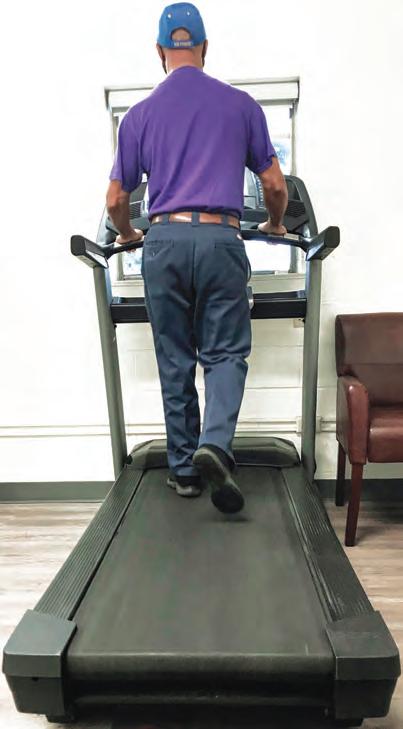

32 • JULY/AUGUST 2022 Join us at the Sherman Senior Center
CENTER FEATURES:
Yoga
Yoga
• Chair
• Adaptive
Chair Volleyball
Fitness Classes
Club
• Treadmills • Stationary Bikes •
• Book
• Movie Matinee
• Pool Tournaments
And so
more! Adults 50 Years and Up 1500 N. Broughton Street, Sherman, Texas 75090 (903) 892-7316
• Art Classes • ZUMBA (Coming Soon)
much









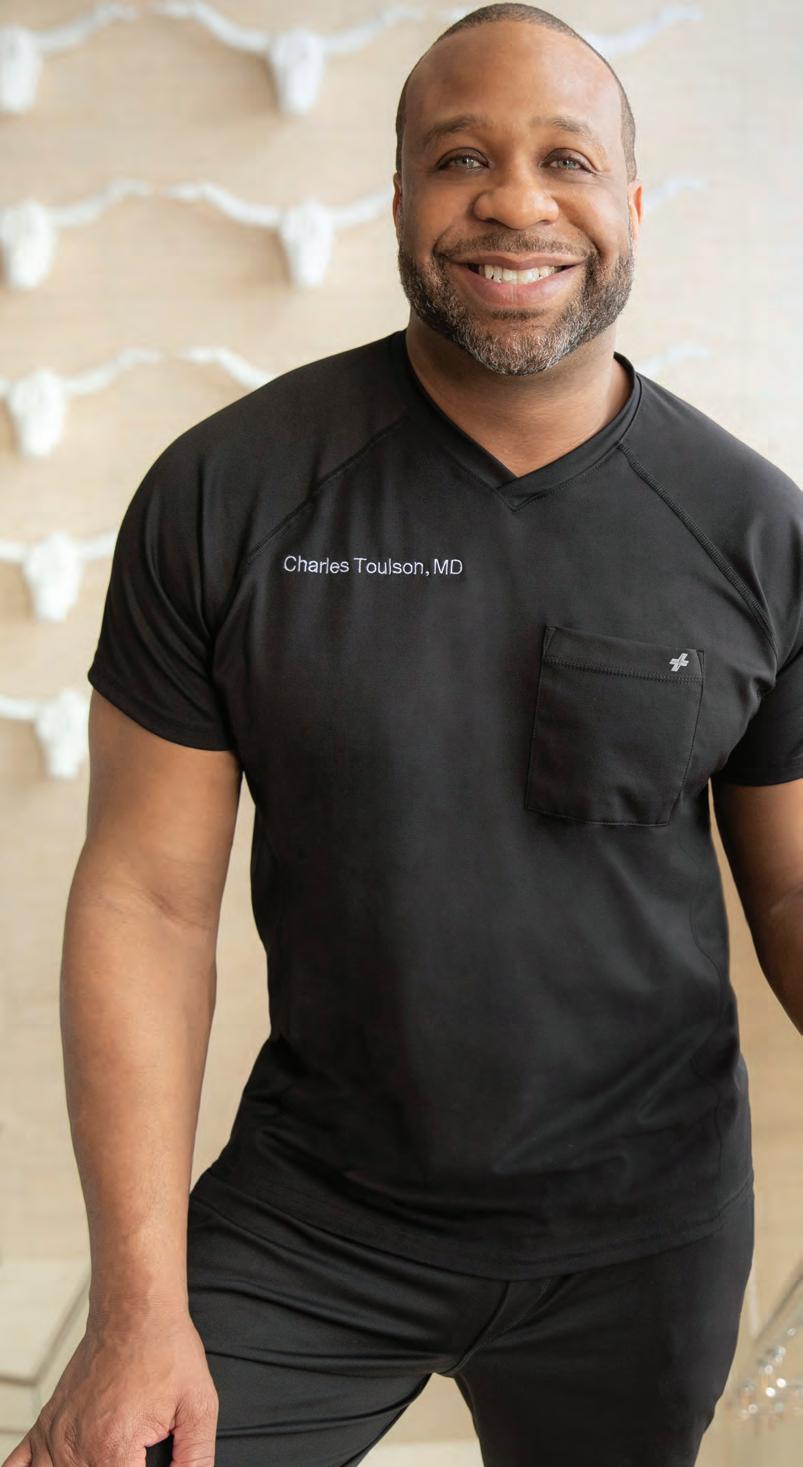

TEXOMA AREA 33 PREMIER
HIP AND KNEE
VOTED TOP DOC IN DALLAS COUNTY AND COLLIN COUNTY. DR. TOULSON IS PROUD TO SERVE LOCAL RESIDENTS AND SURROUNDING COMMUNITIES. TO LEARN MORE, VISIT AlphaOrtho.net Dr. Charles Toulson specializes in: Robotic Joint Replacement
Hip Replacement
Knee Replacement
Knee Replacement Total Hip and Knee Revisions 2 LOCATIONS TO SERVE YOU: McKINNEY 6850 TPC Drive, Suite 116 McKinney, Texas 75070 972-362-0065 SHERMAN 204 Medical Drive, Suite 110 Sherman, Texas 75092 972-362-0253 TOP DOCS 2022 Livingwell PROVIDERS HEALTHCARE AND OTHER
SURGEON FOR
REPLACEMENT
Total
Total
Partial
Stephen P. Courtney, MD
Fellowship-Trained Orthopedic Spine Surgeon
Over 26 Years of Experience
Dr. Courtney is a board-certified orthopedic spine surgeon located in Plano, Texas. A Louisiana native, he attended Louisiana State University for medical school, and completed residency at Texas A&M followed by a fellowship at the Florida Neck and Back Institute.
SPECIALTIES:
• Back Pain
• Neck Pain
• Spine Pain
• Disc Replacement
• Microdiscectomy
• Spinal Fusion
• Minimally Invasive Surgery
• Steroid Injections
• Physical Therapy
“I believe in treating each of my patients with honesty, dignity, and respect. My patients come away from our shared interactions feeling confident, assured that they are truly in the best hands. Throughout my career, I have remained laser-focused on providing world-class care and innovation to the patients I treat on a daily basis. I look forward to getting to know you!”






34 • JULY/AUGUST 2022
Voted Top Doc for Orthopedic Spine Surgeon
Living Well Magazine readers 2018,
2020, 2021 TOP DOCS 2022 Livingwell PROVIDERS HEALTHCARE AND OTHER 2004 Ventura Drive, Suite 200, Plano, Texas 75093 (972) 499-5457 • scheduling@advancedspinecenters.com advancedspinecenters.com
by
2019,
Dear Olivia,
There are many emotions that come along with deciding to put a family member on hospice, and then even more at a loved one’s passing. We have had a few family members who were on hospice in their final days, and we are not sure what resources are available to families such as ours. We would like information about resources that are available to cope with these difficult times.
-Living with Loss
Dear Living with Loss,
The grief and loss experience is unique for each individual impacted by someone’s passing away, but no one should go through the grief process alone. At the Visiting Nurse Association, we have licensed social workers, chaplains, and counselors available to help families navigate the grief and loss process. We have a quarterly bereavement
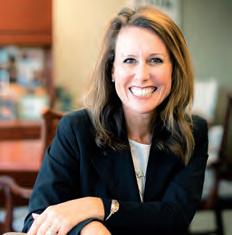
newsletter called Sharing the Journey, as well as other resource information on our website (see QR code). Our bereavement coordinators help families process the changes that come with loss, and they can offer additional community support resources as well, which are also listed on the VNA website, vnatexas.org. Please reach out and let us know if we can help during these challenging times.
~Olivia
Coping with change and loss









VNA Hospice Care focuses on living life to its fullest and treating you with the dignity and respect you deserve. As a nonprofit, our bottom line is patient support and care provided by our highly qualified staff.
To schedule your free in-home informational visit please call (214) 535-2615 or email gethelp@vnatexas.org For volunteer opportunities please call (214) 689-2271 or email volunteer@vnatexas.org
TEXOMA AREA • 35
in health care
vnatexas.org PLACES TO WORK 2020 <ibt iSalla% 11\tmting Ntlll%
OLIVIA ROGERS is a leading voice
and senior services and the Chief Nursing Officer of VNA Texas.

CROSSROADS MEDICAL
204 Me di ca l Drive , Sherman , Texas 7509 2
Jelsma Orthopedics & Sports Medicine ................Suite 100
Richard D. Jelsma, MD
Alpha Orthopedics & Sports Medicine .................Suite 110
➠ Duncan L. McKellar, Jr., MD
➠ Charles E. Toulson, MD, MBA
➠ Jon C. Thompson, MD
➠ Brian J. Snow, MD
Lakeland Pharmacy ............................................ Suite 120
Integrated Pain Management ..............................Suite 140
➠ Deborah Fisher, MD
Areli Medical Devices ..........................................Suite 150
Peak Physical Therapy ........................................Suite 160
➠ Jon Poe, PT, LAT
ENT Centers of North Texas .................................Suite 200
➠ Hunter Richmond, MD
➠ Peter Selz, MD
➠ McDonald Arnot, DO
Sherman Internal Medicine & Primary Care .........Suite 210
➠ Benarji Tegala, MD
Urbanczyk Ortho Suite 220
Helix Health Lab ................................................. ................................................. Suite 130
➠ Jeremy Urbanczyk, DO
Grayson Digestive Disease Consultants ...............Suite 240
➠ Jermaine G. Clarke, DO, MBA
Grayson Digestive Health....................................Suite 240
➠ Joseph Kim, MD
Texoma Weight Loss ...........................................Suite 250
➠ Ikram Kureshi, MD
First Texas Home Health Corporate Office ............Suite 260












TEXAS ONCOLOGY .COM When you’re diagnosed with breast cancer, you need comprehensive care from renowned physicians, advanced treatment options, leading edge technology, and clinical trials. But you also need to keep being Mom. To be front row at every soccer game and gymnastics meet. To be home for family game night. With more than 210 locations across the state, Texas Oncology provides expert care and keeps you close to family and friends. Because you shouldn’t have to choose. 903.868.4700 EXPERT BREAST CANCER CARE RIGHT WHERE YOU LIVE.



TEXOMA AREA • 39

What Makes Us Laugh?
The History of Laughter and Science Behind Its Medicinal Effects
By KIMBERLY BLAKER
Whether you guffaw, chuckle, chortle, cackle, roar, howl, or giggle, the ability to laugh is shared by all people around the world. Humans even share this ability with apes and other primates! Charles Darwin and many other researchers have recorded observations of laughing in various primate species during play and especially when being tickled. These findings suggest the ability to laugh goes back millions of years to a shared ancestor. Tickling may not be what makes you laugh, but everyone has something that tickles their funny bone. Although the jokes people tell have shifted and developed throughout history, laughter’s positive benefits are unaltered.
How do laughter and humor affect our health?
Laughter may really be the best medicine. Scientific research has backed up the positive effects a good laugh can have on your physi-
cal, mental, and emotional health. Laughing is so beneficial to health that laughter therapy has even become an alternative approach to treating depression, stress, and other mood disorders. Evidence from numerous studies finds laughter to be an effective method in cognitive-behavioral therapy because of its effects.
Gelotology is the term used to describe the study of laughter. This field was developed in the late 1960s and examines the physiological and psychological effects of humor. One of the founders was William F. Fry, who would watch comedic movies while drawing blood samples. The results showed that laughter increased the activity of immune system cells.
Norman Cousins was a big proponent of laughter as medicine. At the age of 50, he was struck with a disease with a low recovery rate. But he noticed that he experienced less pain and fewer symptoms when laughing. He prescribed himself regular laughter by watching
40 • JULY/AUGUST 2022
Candid Camera and Marx Brothers movies and lived another 25 years. He worked with the California University Hospital to study the health effects of laughter more formally.
Just a few of the recorded benefits of laughter on mental, physical, and emotional health include:
• Increased endorphin levels
• Increased production of immune cells and antibodies
• Decreased levels of stress-causing hormones like cortisol and epinephrine
• Improved memory
• A refreshing mental break that helps replenish mental resources
• Strengthened social bonds
• Increased intake of oxygen, which stimulates organs
• Reduced muscle tension
• Ability to better handle scary or stressful situations
As our understanding of the benefits of laughter has grown, people have started to incorporate laughter for other aspects of health, too.
A physician from India, Madan Kataria, created laughter yoga which combines breathing, movement, and laughter to promote mental and physical health. A study examined the effect of this method on older adult women experiencing depression in comparison to a control group that used exercise therapy. Those who completed laughter yoga reported significantly higher life satisfaction and improvements in their depression compared to the control group. The study found laughter yoga to be as effective as exercise programs.
The Association for Applied and Therapeutic Humor is a non-profit organization started by a group of psychologists who promote the use of humor to support improved health and well-being. They have an extensive research library that shares academic research related to the benefits of humor and laughter.
Counselor and stand-up comedian, Richard Granirer, of Stand Up for Mental Health, uses stand-up comedy to educate the public about mental health and reduce the stigma around it. He also teaches those with mental health issues or disorders to utilize their struggles to create comedy, which gives them a sense of control and self-worth.
How has humor changed over time?
Humor as a source of laughter has been around as long as humans have been able to communicate. According to Robert R. Provine, a laughter expert, “The necessary stimulus for laughter is not a joke, but another person.” Laughter seems to have evolved as an essential part of social interaction, even if it does not happen face-to-face. The current thought is that humor is based on the recognition to observe or create incongruities in a social setting, and as humans’ cognitive abilities and language has developed, so has humor. Play-fighting may be one of the earliest forms of humor due to the mix of playfulness with fighting behavior.
In 2008, a group of British historians hunted down the oldest recorded joke—a fart joke—in Sumeria in 1900 B.C. It was inscribed on a tablet and translates to: “Something which has never occurred since time immemorial; a young woman did not fart in her husband’s lap.” Although the words used may change, jokes at their core tend to make light of similar ideas—like fart jokes or toilet-related humor.
Top 10 oldest jokes from history, discovered by researchers led by humor expert Dr. Paul McDonald, reinforce the idea that at their heart, jokes have not changed too much over time. Humor has always dealt with “taboos,” witty retorts, pointing out ironies, making light
of difficulties, or come at someone’s expense. The format of jokes may change, and the details may shift to reflect the times, but the basic elements remain the same.
Throughout history, humor has developed to reflect the times as people used laughter to connect. What people find funny varies based on individual and shared experiences. Humor generally reflects current events and stages of life and can be a way to relate to others. Shared humor relies on shared context and understanding of content. So, people may not be able to appreciate jokes that have a more specific connection to a particular group. Some types of humor may be more global and relate to the basic human experience. In contrast, others have a narrower audience that can appreciate them.
Jokes and humorous content have also been shared in a variety of different ways, depending on the technology available. Humor can be shared in any way that people communicate. Jokes have been shared through every medium imaginable— carved on tablets, written in newspapers, sent in letters, graffitied on walls, or told by entertainers like court jesters and stand-up comedians.
The rise of technology has also led to alternative ways of sharing humor. In the 1950s, Charley Douglass, a sound engineer for CBS, created laugh tracks to make a shared experience of laughter for people watching at home. Today, humor can be shared far and wide through the internet and social media in the form of memes or videos.
Humor and laughter are universal and vital parts of a happy and healthy life. Keep your spirits up by finding ways to keep laughing. Though each person’s sense of humor may be a little different, you just have to seek out what you find funny or enjoyable. Especially when you are feeling down, it is even more important to try to find something to laugh at to lighten your load. Socialize with people who make you laugh for a boost. Sign up for a daily joke or comic strip. Follow your favorite comedian. Keep a running list of books, songs, tv shows, or movies that make you laugh. Or start a ‘funny file’ for emergencies with cards and pictures that bring a smile to your face. Even if you don’t feel like laughing, try forcing a few chuckles—the more ridiculous, the better. You’ll likely find yourself genuinely laughing before you know it!
Laughing is so beneficial to health that laughter therapy has even become an alternative approach to treating depression, stress, and other mood disorders.
TEXOMA AREA • 41





42 • JULY/AUGUST 2022 “We Chose WNJ!” wnj.org | 903-870-4611 | 500 N. Highland in Sherman Highly-qualified Doctors & Staff • Women’s Center • Level II Primary Stroke Center • Level III Trauma Center Family-friendly Maternity Suites • Excellent Cardiac Care • Dedicated Trauma/Orthopedics/Surgery Unit Behavioral Health Services Inpatient Facility
Dr. Grant Craig
Pastor Terry Barnett
Natalie, Jeremy and Champ Roberts
Mayor David and Mignon Plyler
Feel like Youagain.

Rahul Banerjee, MD is a board-certified, fellowship-trained orthopaedic surgeon who specializes in hip and knee replacement, comprehensive management of fractures, and treatment of complex orthopaedic problems. Dr. Banerjee graduated from the University of Chicago Pritzker School of Medicine and completed his residency and fellowship at Brown University.

After training, Dr. Banerjee served in the United States Air Force and worked with the Army treating the injured and training residents in El Paso, TX. He was deployed to the War in Iraq and treated many soldiers and civilians.
After his military service, Dr. Banerjee joined the faculty at University of Texas Southwestern as Assistant Clinical Professor. In 2021, Dr. Banerjee joined North Texas and Orthopaedic Spine. Dr. Banerjee is available to see patients at office locations in Plano, Carrollton and Dallas.
• Total Hip Replacement
• Direct Anterior Hip Replacement
• Knee Replacement
• Treatment of Fractures
• Bone Deformity
• Nonunion of Fractures
• Limb Lengthening
• Elbow Injuries / Elbow Replacement
• Foot and Ankle Injuries
• Infections
• Total Hip Revision
• Total Knee Revision
“From the moment I met Dr. Banerjee, he listened to what I had to say and how I felt, that means a lot to me. After many years of knee pain and not being able to live the lifestyle I wanted, he agreed to do a total knee replacement. It was the best decision I ever made. He did an amazing job! Less than two months out and I am walking and biking like I haven’t been able to in years! It really changed my life!!!”
–David P.

TEXOMA AREA • 43
(214) 592-9955 www.ntosonline.com
Experienced DWI Defense THE LAWYER LAWYERS CALL

Deandra M. Grant
JD, GC, MS

Attorney Deandra M. Grant is the Managing Partner of Deandra Grant Law’s five offices. She is an international speaker on DWI law, science and trial skills. As the author of the annually updated Texas DWI Manual, she is viewed by her peers as being a leader in her field. Deandra understands the science behind alcohol absorption and elimination rates and can use this knowledge to competently defend you.
Deandra formerly was an assistant district attorney. Her tenure as a prosecutor focused on DWI prosecutions which has given her firsthand knowledge on how to counter the prosecutor’s evidence and strategy. Deandra has spent hundreds of hours in training courses and programs related to DWI defense and has completed the certification course to administer standard field sobriety testing (SFST), the same training course taught to police officers nationwide on how to identify drunk drivers during traffic stops. As a certified SFST Instructor, Deandra has taught the course to other attorneys. She’s also completed the coursework on DWI forensic blood and urine testing.


GRANT DEANDRA
“I have a masters degree in pharmaceutical science and a graduate certificate in forensic toxicology. I am able to take apart evidence in ways a lot of other attorneys are not able to do. The most important part of my job is being the barrier between the government and my client. Standing between them. Making sure their rights are protected.”
–DEANDRA GRANT


44 • JULY/AUGUST 2022
3300 Oak Lawn, Ste. 700, Dallas, TX 75219 (972)943-8500 | TexasDWISite.com texas trial attorneys
Co-Author of the Texas DWI Manual


When you need top quality parts and service, look to Plano Power Equipment.
To keep your equipment in top shape, you can count on Plano Power Equipment’s retail pats sales and servicing of Toro®, Echo®, Scag®, equipment using genuine manufacture parts.



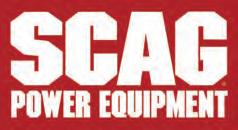


MOW LIKE THE PROS!
Experience the residential zero-turn riding mower with commercial mower features.

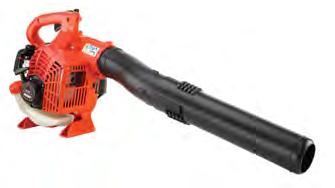




STARTING AT $14999 CUT MOWING TIME IN HALF FULLY SERVICED & READY TO GO TO WORK FOR YOU Starting at just $99/mo 0% RETAIL FINANCING 50” TimeCutter® Count on it. 1414 N. Central Expy. Plano, TX 75074
Premier Foot & Ankle specializes in the treatment of all foot and ankle issues patients of all ages may experience. Our dedicated providers are committed to providing patients with quality care and pain relief using cuttingedge technology such as Pulse Activation Treatment to cure heel pain/plantar fasciitis as well as Padnet vascular and Smart Scan nerve testing for diabetics. By for the entire family, we at Premier Foot & Ankle focus on treating both the injured athlete and anyone with foot or ankle injuries.
Premier Foot & Ankle is the leading practice of foot and ankle specialists in the Dallas-Ft. Worth area as evidenced by multiple awards such as the Best of Dallas 2011-2012 and 2015-2020 and the Reader’s Choice Best of Living 2017. As a trusted and dedicated
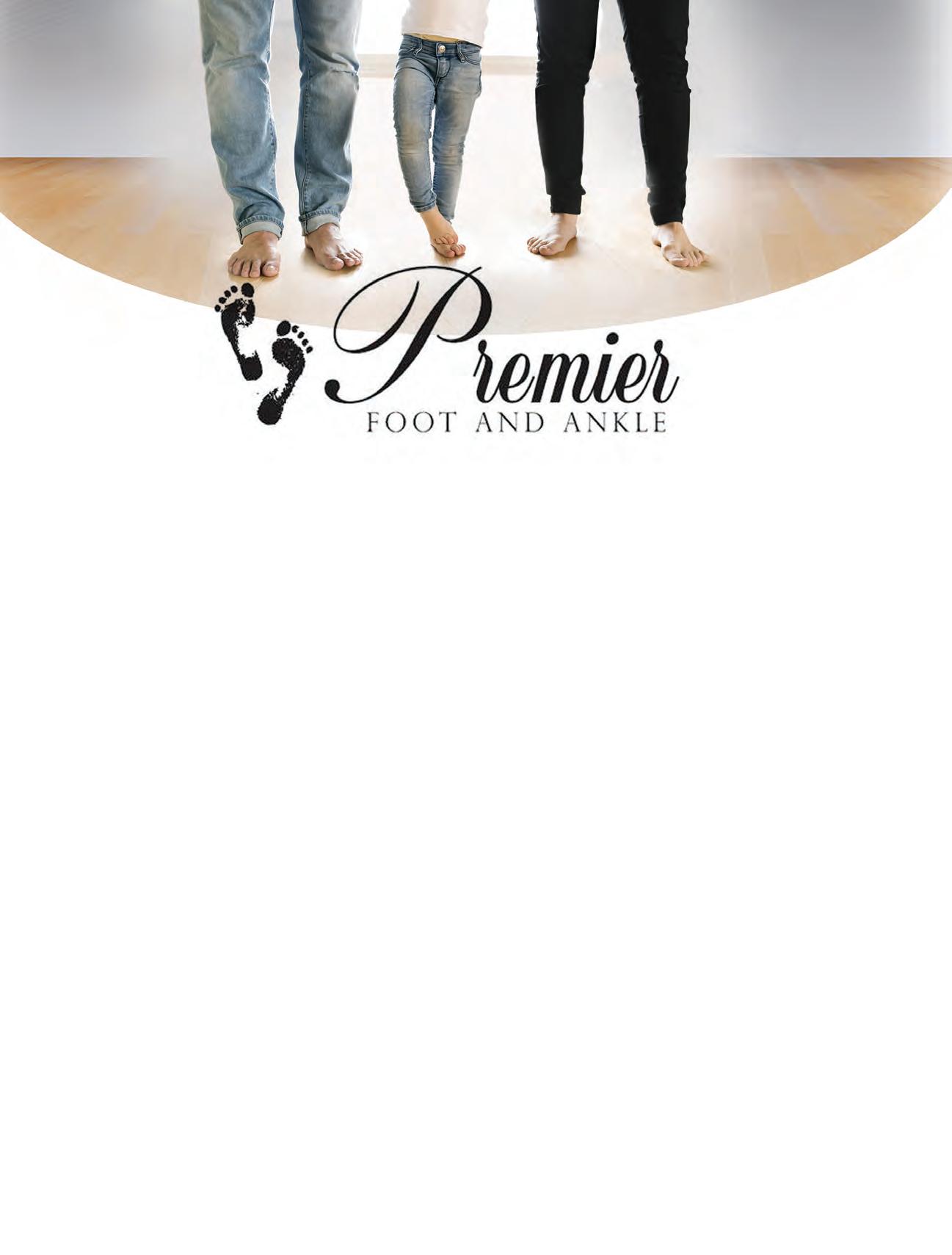

provider, Premier Foot & Ankle is here to help patients alleviate their foot and ankle pain resulting from various foot disorders and injuries such as sports and diabetic foot care.
To move toward your pain-free lifestyle with an individualized comprehensive treatment plan, visit us today at www.premierfoot.com to schedule your appointment!
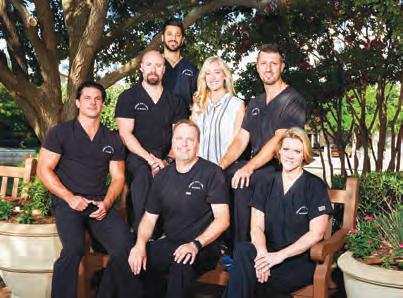
Serving adults and children with clinics in: Sherman, TX 903.309.1410 McKinney, TX 972.217.7864 Plano, TX 972.295.9661 Mesquite, TX 972.318.9048 Frisco, TX 214.473.5877 Celina, TX 972.346.1993 Dallas, TX 214.504.3923 Allen, TX 469.208.3777
It’s essential to take care of your feet !
Before, During, and After Cataract Surgery
Courtesy KEY-WHITMAN EYE CENTER

If cataract surgery has been recommended for your eyes, you are not alone. Truth is, we will all develop cataracts, reducing our quality of vision, as we age. Gratefully, cataract surgery procedures have become more advanced and is safe, painless and effective.
If you are thinking about having cataract surgery, you most likely have a lot of questions regarding when you should have it done, what you can expect, and how to prepare for surgery. Read on to see some helpful tips from Dr. Whitman at Key-Whitman.
What Are The Common Symptoms Of Cataracts?
The complaint we hear most from cataract patients is difficulties with their night vision. They begin to experience a lot of glare, halos and starburst symptoms, especially when driving. We also hear complaints of a haze or fog obstructing their vision and they’ll notice their vision gets blurrier over time.
How Do I Prepare For Cataract Surgery?
Before your procedure, our patients undergo a preoperative exam to gather measurements to determine the level of correction needed and review the types of intraocular lens options available. We will also schedule a visit to listen to your heart and lungs as well as review prior anesthesia and surgeries, medical history and medications to ensure they’re physically healthy enough to have cataract surgery.
Key-Whitman also has counselors who will walk our patients through the process, review insurance coverage and make sure the lens option the patient selects best meets their goals. If there is an eye drop protocol associate with their surgery, the counselor will also go through the drop sequence involved—antibiotics and non-steroidal anti-inflammatories—well in advance of the procedure.
Be sure to have a friend or family member to accompany you to surgery, as you won’t be allowed to drive yourself home due to the twilight sedation.
How Do I Know It’s Time To Have Cataract Surgery?
When your cataracts have worsened to the point where they prevent
you from performing day-to-day tasks and interfere with your quality of life, it is time to consider cataract surgery.
Cataracts worsen gradually, and we start to make a lot of accommodations for our vision as we get older. Essentially, we assume how well we see is normal. But if it gets to the point where you’re afraid to drive at night, can’t see well enough to safely take your medication or do household chores, and feel a loss of independence due to failing vision, cataract surgery can allow you to enjoy life again.
What Misconceptions Do People Have About Cataract Surgery?
In the past, cataract surgery was quite invasive, there were fewer lens options, and healing took much longer. This isn’t the case today. The biggest misconceptions people have is that the procedure is painful and complicated. That couldn’t be farther from the truth today.
What Can I Expect Following Cataract Surgery?
Following your surgery, your surgeon will review the procedure with you and answer any questions you may have at that time. Typically, patients leave with a protective eye patch, which will be removed at their follow-up visit the next day. Subsequent follow-up examinations will be scheduled approximately every two weeks until the eye is healed.
Healing post-surgery is also easier for most cataract patients today. “Key-Whitman uses the most advanced technology available, so healing occurs more quickly and with fewer complications. Even better, once the eyes have healed and adjusted, most patients are surprised by the improvement in their vision. They can see clearly again and notice how colors are much more vibrant than before with cataracts. Depending on the type of intraocular lenses patients choose, many become less dependent on glasses,” Dr. Whitman says.
You should also be aware that the surgeon won’t operate on both eyes during the same visit. Surgeries are typically scheduled one to two weeks apart. This allows plenty of time for the first eye to heal and the patient to realize the full extent of correction in that eye.
48 • JULY/AUGUST 2022
Key-Whitman Eye Center celebrates over 60 years of providing excellence in eye care to North Texas. The Plano clinic has provided services in Collin County for 20 years.
Dr. Kimberly Warren is board certified in general ophthalmology by the American Board of Ophthalmology and specifically board certified in LASIK and cataract surgery by the American Board of Eye Surgery. She has been an integral part of the Key-Whitman staff since 2000. She resides in Plano with her husband and three children.
Dr. Faisal Haq is also board certified in general ophthalmology by the American Board of Ophthalmology and specifically board certified in LASIK and cataract surgery by the American Board of Eye Surgery. He joined Key-Whitman in 2006 and lives in Plano with his wife and two children.


Dr. Warren and Dr. Haq provide a full range of adult vision services, including comprehensive eye exams, management of glaucoma and corneal disease, and cataract surgery.

See Better. Look Better. Feel Better.
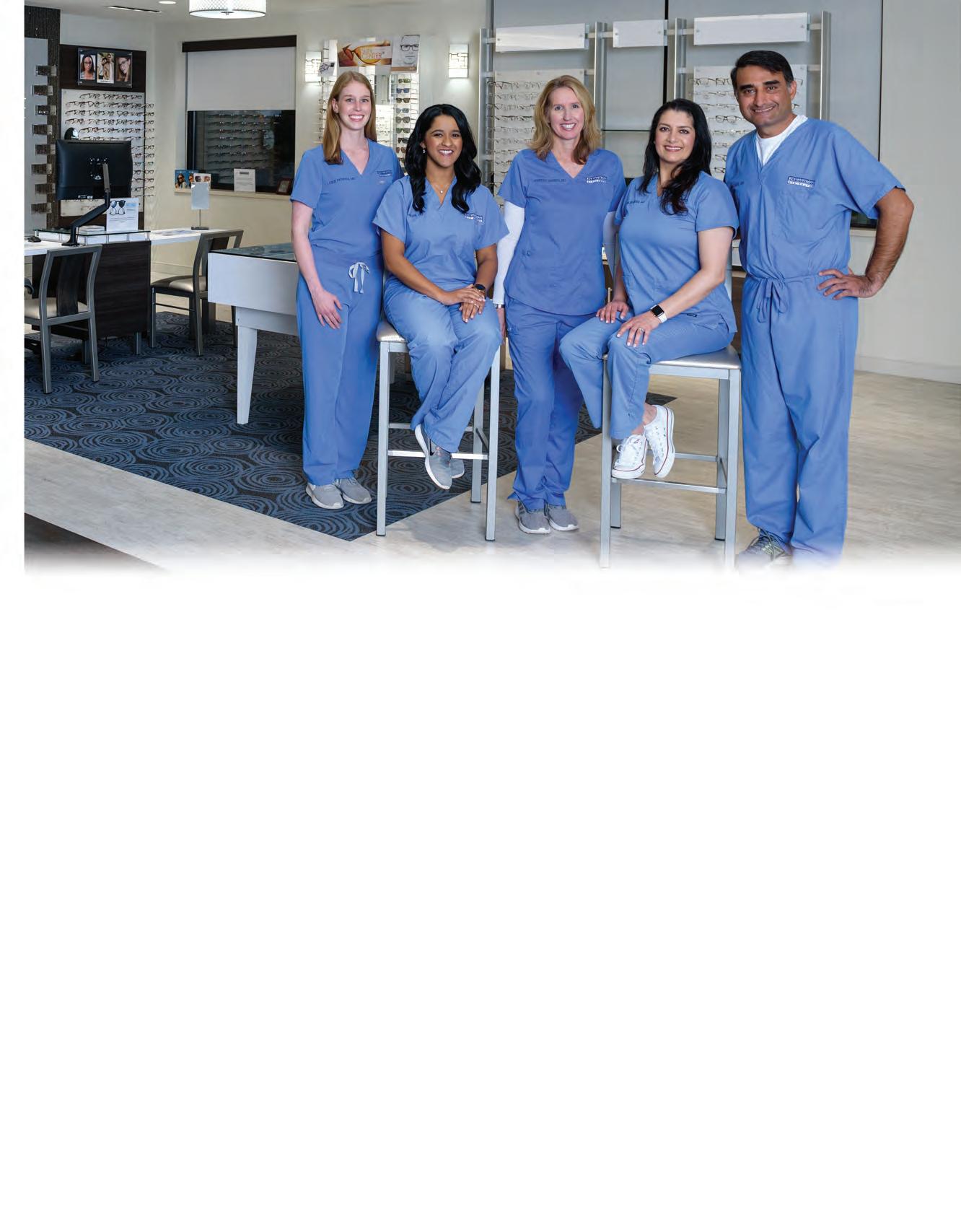

• Comprehensive Adult Eye Care
• Comprehensive Adult Eye Care
• Cataract Surgery
• Light Adjustable Lens, Synergy™, Symfony®, PanOptix, Vivity®, EVO Visian ICL™ and the Toric IOL
• Symfony®,Crystalens®, Tecnis® PanOptix & the Toric IOL
• Management of Glaucoma & Corneal Disease
• Management of Glaucoma & Corneal Disease
• Eyelid Surgery & Botox®
• Eyelid Surgery & Botox®
• Laser Vision Correction
• Laser Vision Correction
Give us a call today 972-769-2020 or Toll-Free 800-442-5330 www.keywhitman.com
Convenient locations to serve you in Dallas, Plano, Richardon, Mesquite, Frisco, Arlington, Rockwall and North Fort Worth.
Seven locations to serve you Dallas, Plano, Mesquite, West McKinney, North Arlington, Rockwall and South Arlington.
(username:
Give us a call today 972-769-2020 or Toll-Free 800-442-5330 www.keywhitman.com Follow us on (username: keywhitman)



Everything We Do is Focused on You
From left to right are: Leslie Pfei er, M.D.; Anita Jacob, O.D.; Kimberly Warren, M.D.; Sadaf Razi ElHa ar, O.D.,; Faisal Haq, M.D.
TOP DOCS 2022 Livingwell PROVIDERS HEALTHCARE AND OTHER
Follow
us on
keywhitman)

SPECIALIZED WOUND CARE
Our team of specialists uses an advanced clinical approach, including hyperbaric oxygen therapy, to reduce your healing time.
Working together with your healthcare provider, our trained staff will get you back to living your daily life.
WE TREAT ALL WOUNDS INCLUDING, BUT NOT LIMITED TO:
•Diabetic foot ulcers
•Venous ulcers
•Pressure ulcers
•Surgical wounds
•Traumatic wounds
•Arterial ulcers
•Late effects of radiation treatments
•Compromised skin grafts and flaps
•Crush injuries
MEET OUR PHYSICIAN PANEL
Dr. Minaxi Rathod
Infectious Disease/HBO/Wound Care
Dr. Jennifer Laing
Family Practitioner/HBO/Wound Care
If you have a wound or an ulcer that is not healing, or any wound that is of concern, ask your physician for a referral to the wound center or contact us directly for an appointment.
50 • JULY/AUGUST 2022 CHOOSE WILSON N. JONES
(903)891-2139 500 N. Highland Ave | Sherman, TX 75092 www.wnj.org
We work together to heal your wound















































 Charles Dannel
Charles Dannel









































































































































